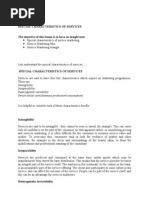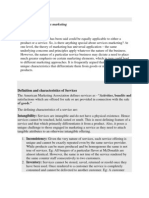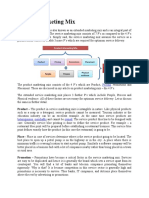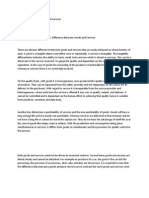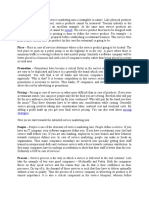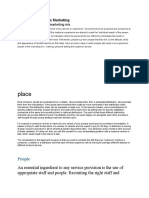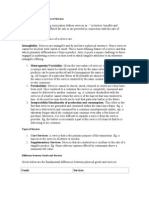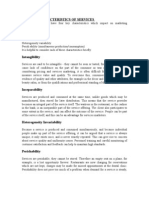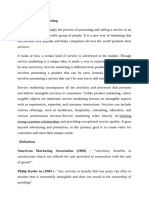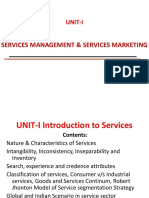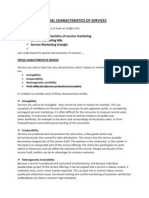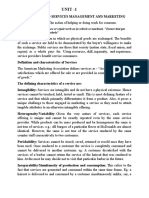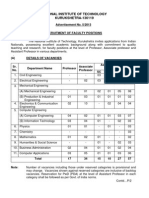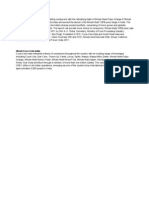Intangibility
Uploaded by
Satywan SainiIntangibility
Uploaded by
Satywan SainiCHARACTERISTICS OF SERVICES Intangibility Services are essentially intangible.
Because services are performances or actions rather than objects, they cannot be seen, felt, tested, or touched in the same manner that we can sense tangible goods. For example, health-care services are actions (e.g. surgery, diagnosis, examination, treatment) performed by providers and directed toward patients and their families. These services cannot actually be seen or touched by the patient, although the patient may be able to see and touch certain tangible components of the service (e.g. equipment, hospital room). In fact, many services such as health care are difficult for the consumer to grasp even mentally. Even after a diagnosis or surgery has been completed the patient may not fully comprehend the service performed. Inseparability Services are created and consumed simultaneously and generally they cannot be separated from the provider of the service. Thus the service provider customer interaction is a special feature of services marketing. Unlike the tangible goods, services cannot be distributed using conventional channels. Inseparability makes direct sales as the only possible channel of distribution and this delimits the markets for the sellers services. This characteristic also limits that scale of operation of the service provider. For example, a doctor can give treatment to limited number of patients only in a day. This characteristic also emphasizes the importance of the quality of provider client interaction in services. This poses another management challenge to the service markets. While a consumers satisfaction depends on the functional aspects in the purchase of goods, in the case of services the above mentioned interaction plays an important role in determining the quality of services and customer satisfaction. For example, an airline company may provide excellent flight service, but a discourteous onboard staff may keep off the customer permanently from that company. There are exemptions also to the inseparability characteristic. A television coverage, travel agency or stock broker may represent and help marketing the service provided by another service firm. Heterogeneity This characteristic is referred to as variability by Kotler. We have already seen that services cannot be standardized. They are highly variable depending upon the provider and the time and place where they are provided. A service provided on a particular occasion is somewhat different from the same service provided on other occasions. Also the standard of quality perceived by different consumers may differ according to the order of preference given by them to the various attribute of service quality. For example, the treatments given by hospital to different persons on different occasion cannot be of the same
quality. Consumers of services are aware of this variability and by their interaction with other consumers they also get influenced or influence others in the selection of service provider.
Perishability and Fluctuating Demand Perish ability refers to the fact that services cannot be saved, stored, resold or returned. A seat on an airplane or in a restaurant, an hour of a lawyers time, or telephone line capacity not used SERVICE MARKETING MIX The service marketing mix is also known as an extended marketing mix and is an integral part of a service blueprint design. The service marketing mix consists of 7 Ps as compared to the 4 Ps of a product marketing mix. Simply said, the service marketing mix assumes the service as a product itself. However it adds 3 more Ps which are required for optimum service delivery. The product marketing mix consists of the 4 Ps which are Product, Pricing, Promotions and Placement. These are discussed in my article on product marketing mix the 4Ps.The extended service marketing mix places 3 further Ps which include People, Process and Physical evidence. All of these factors are necessary for optimum service delivery. Let us discuss the same in further detail.
Product The product in service marketing mix is intangible in nature. Like physical products such as a soap or a detergent, service products cannot be measured. Tourism industry or the education industry can be an excellent example. At the same time service products are heterogeneous, perishable and cannot be owned. The service product thus has to be designed with care. Generally service blue printing is done to define the service product. For example a restaurant blue print will be prepared before establishing a restaurant business. This service blue print defines exactly how the product (in this case the restaurant) is going to be.
Place -Place in case of services determine where is the service product going to be located. The best place to open up a petrol pump is on the highway or in the city. A place where there is minimum traffic is a wrong location to start a petrol pump. Similarly a software company will be better placed in a business hub with a lot of companies nearby rather than being placed in a town or rural area. Promotion Promotions have become a critical factor in the service marketing mix. Services are easy to be duplicated and hence it is generally the brand which sets a service apart from its counterpart. You will find a lot of banks and telecom companies promoting themselves rigorously. Why is that? It is because competition in this service sector is generally high and promotions is necessary to survive. Thus banks, IT companies, and dotcoms place themselves above the rest by advertising or promotions. Pricing Pricing in case of services is rather more difficult than in case of products. If you were a restaurant owner, you can price people only for the food you are serving. But then who will pay for the nice ambience you have built up for your customers? Who will pay for the band you have for music? Thus these elements have to be taken into consideration while costing. Generally service pricing involves taking into consideration labor, material cost and overhead costs. By adding a profit markup you get your final service pricing. You can also read about pricing strategies. People People is one of the elements of service marketing mix. People define a service. If you have an IT company, your software engineers define you. If you have a restaurant, your chef and service staff defines you. If you are into banking, employees in your branch and their behavior towards customers defines you. In case of service marketing, people can make or break an organization. Thus many companies nowadays are involved into specially getting their staff trained in interpersonal skills and customer service with a focus towards customer satisfaction. In fact many companies have to undergo accreditation to show that their staff is better than the rest.Definitely a USP in case of services. Process Service process is the way in which a service is delivered to the end customer. Lets take the example of two very good companies Mcdonalds and Fedex. Both the companies thrive on their quick service and the reason they can do that is their confidence on their processes. On top of it, the demand of these services is such that they have to deliver optimally without a loss in quality. Thus the process of a service company in delivering its product is of utmost importance. It is also a critical component in the service blueprint, wherein before establishing the service, the company defines exactly what should be the process of the service product reaching the end customer. Physical Evidence The last element in the service marketing mix is a very important element. As said before, services are intangible in nature. However, to create a better customer experience tangible elements are also delivered with the service. Take an example of a restaurant which has only chairs and tables and good food, or a restaurant which has ambient lighting, nice music along with good seating arrangement and this also serves good food. Which one will you prefer? The one with the nice ambience.
Thats physical evidence. Several times, physical evidence is used as a differentiator in service marketing. Imagine a private hospital and a government.
NEW SERVICE DEVELOPMENT There are two levels of service innovation for new service development, including radical innovations and incremental innovations. For radical innovations, major innovation is new service driven by information and computer based technology. Besides, new service for existing market is called start up business. New services for the market presently served are new services to customers of an organization. In the other hand, incremental innovations like service line extensions which is augmentation of existing service line (e.g. new menu items). Furthermore, service improvements which changes in features of currently offered service and style changes like modest visible changes in appearances are the examples of incremental innovations. In addition, new service development cycle is different from the one we are used to know. The new service development design considerations can be explained as follows: 1. Delivery system : What does the customer see, where does production occur? In B2B can we seamlessly move information from one processing point to the next? 2. Facilities design : Size, layout, how does it feel? Important in B2C if people are uncomfortable they probably wont come back. 3. Capacity planning : Queues and demand. Typically we dont plan for full capacity which would result in waste. What do we do with excess capacity? What do we do with customers when we have to make them wait? 4. Service encounter : Employee training and empowerment. The culture your people experience affects their ability and willingness which in turn affects customer relationships. 5. Quality : Measurements and managing expectations. Service quality is covered in another module. 6. Managing capacity and demand : Adjusting your plans to accommodate customer requirements, or is there a way to drive demand to map to your ability to deliver (think of happy hour). 7. Information: What to collect, keep, for competitive advantage. At issue here is privacy and who really owns the data? Can you think of any service that doesnt depend on information?.
NEW SERVICE DEVELOPMENT PROCESS
SERVICE CONSUMER BEHAVIOR This is defined as the actions & beliefs that guide a person to purchase a particular product or service. The emphasis on services by companies across the worlds has led to a growth in the expectations of customers today. The customer seeks customised services at his doorstep & is himself involved in defining the kind of service he expects. The purchase decisions of customers are not made in isolation, but rather they are influenced by environmental factors such as culture, social class, family & other institutional factors. The study of CB requires inputs from various disciplines, such as sociology, psychology & economy. CB deals with the study of the factors that influence a customer in purchasing a product, service and the process that he goes through, to evaluate the product/service prior to & even after its purchase & use. THE CONSUMER BUYING PROCESS 1. Need arousal: The buying process starts with need arousal. A need can be activated through internal or external stimuli. A need can also be aroused by an external stimulus such as sight of a new thing in a shop while purchasing other things. There is two-fold significance of need arousal stage to a marketing man. 1.First the marketer must identify the drive that might actually or potentially connect to the product class or brand and make the buyer feel that the product can satisfy the drive, he feels, and
2.It also helps recognize that the need levels for the product fluctuate over time and are triggered by different cues. The marketer can arrange cues to conform better to the natural rhythms and timing of need arousal. 2. Information search: After need arousal, the consumer tries to solve it and gathers the sources and information about the product. Depending upon the intensity of need, it produces two states of individual. The first state is called heightened attention when the consumer becomes more receptive to the information regarding the item he needs. If a consumer needs to purchase a television, he will pay more attention to TV ads and the remarks made by friends and associates about TVs. If need is more intense, the individual enters a state of active information search and he tries to collect more information about the product, its key attributes, qualities of various brands and about the outlets where they are available. There are four consumer information sources. (i) Personal sources (family, friends, neighbors etc.) (ii) Commercial sources (advertisements, salesmen, dealers). (iii) Public sources (mass media, consumer-rating organizations). (iv) Experiential sources (handling, examining, using the product). Identifying the information sources and their respective roles and importance calls for interviewing consumers about the sources of information and can use the findings to plan its advertisements. 3.Evaluation behavior: Having collected the information, the consumers clarify and evaluate the alternatives. There is, unfortunately no simple and single evaluation process used by all consumers or even by one consumer in all buying situations. The most current process of evaluation is to judge the product largely on a conscious and rational basis. Various considerations form the part of judgment such as product attributes, importance, weights, brand image, utility function for each attribute, and attitude etc. After evaluation of various alternatives, he takes the decision to buy. 4. Purchase decision: Evaluation behavior leads the consumer to form a ranked set of preferences. Normally a consumer buys the article, he or she likes most but there are three more important consideration for taking the buying decision: (a) attitude of other such as of wife, relatives, and friends, (b) anticipated situational factors as expected family income, expected total cost of the product and the expected benefits of the product; (c) unanticipated situational factors as looks or manner of the salesman or the way business is carried on. The marketer must consider these factors and should try to provoke the feeling of risk in the consumer And attempt to provide information and support that will help him. 5. Post purchase feelings: After buying and trying the product, the consumer will feel some level of satisfaction or dissatisfaction and level of satisfaction depends very much on the expectation and the product's perceived performance. If the product matches up to his expectations, the consumer is satisfied; if it exceeds, he is highly satisfied; and if it falls short of expectations, he is dissatisfied.
Participants in the buying process
There are the following different roles that persons can play in a buying decision: Initiator: The initiator is a person who first suggests or think of the idea of buying the particular product. For example, publisher of a book initiates the professor to ask the students of his class to purchase the book. Here publisher is the initiator, the first person to initiate the buying process. Influencer: Influencer is a person who explicitly or implicitly has some influence on the final buying decision of others. Students are influenced by the advice of the professor while taking a decision to purchase a book. Here professor is the influencer. Decider: The decider is a person who ultimately determines any part or whole of the buying decision, i.e., whether to buy, what to buy, how to buy, when to buy or where to buy. Children are the deciders for buying the toys, house lady for kitchen provisions, and head of the family for durable or luxury items. Buyer: The buyer is the person who actually purchase. Buyer may be the decider or he may be some other person. Children (deciders) are the deciders for purchasing the toys, but purchases are made by the parents.s User: User is the person who actually uses or consumes the services or products.
FACTORS AFFECTING CONSUMER BEHAVIOR
1. Cultural Factors Consumer behavior is deeply influenced by cultural factors such as: buyer culture, subculture, and social class. Culture: Basically, culture is the part of every society and is the important cause of person wants and behavior. The influence of culture on buying behavior varies from country to country therefore marketers have to be very careful in analyzing the culture of different groups, regions or even countries. Subculture: Each culture contains different subcultures such as religions, nationalities, geographic regions, racial groups etc. Marketers can use these groups by segmenting the market into various small portions. For example marketers can design products according to the needs of a particular geographic group. Social Class: Every society possesses some form of social class which is important to the marketers because the buying behavior of people in a given social class is similar. In this way marketing activities could be tailored according to different social classes. Here we should note that social class is not only determined by income but there are various other factors as well such as: wealth, education, occupation etc. 2. Social Factors Social factors also impact the buying behavior of consumers. The important social factors are: reference groups, family, role and status.
Reference Groups: Reference groups have potential in forming a person attitude or behavior. The impact of reference groups varies across products and brands. For example if the product is visible such as dress, shoes, car etc then the influence of reference groups will be high. Reference groups also include opinion leader (a person who influences other because of his special skill, knowledge or other characteristics). Family: Buyer behavior is strongly influenced by the member of a family. Therefore marketers are trying to find the roles and influence of the husband, wife and children. If the buying decision of a particular product is influenced by wife then the marketers will try to target the women in their advertisement. Here we should note that buying roles change with change in consumer lifestyles.
INTEGRATED MARKETING Integrated marketing brings together a range of different marketing tactics, offering them at onetime so they become one complete marketing solution. Instead of looking at marketing in terms of several independent marketing services, integrated marketing bundles them together as one service. The main difference between integrated services and other marketing is that one is managed by a single company while the other may involve a number of marketing companies. By working only with one company, you dont have to worry about services crossing over or doubling up. As one marketing handles all of the different forms of your marketing, they become experts in your business. This thorough understanding of your business leads to marketing which is nearly impossible when working with several companies at the sometime. INTEGRATED MARKETING OF SERVICES Integrated Marketing(IM) is the management strategy that utilizes different forms of media, which focuses primarily on the brand and image development of businesses. Integrated Marketing services include elements from business branding, advertising and relations to traditional marketing methods such as print media, radio and television advertising to nontraditional marketing such as search engine marketing ,optimization pay per click advertising, and social media Most of the Improvisers use most of these tools and they are integrated and coordinated to make a cohesive and efficient campaign for your business services are broadly divided into two categories online marketing and offline marketing. Although the marketing strategies work in different platforms but they compliments each other very well. Online is still a new concept than the offline marketing. But with the advancement in the World Wide Web these online integrated marketing services have improved and gained popularity in no time.
Indeed, the traditional offline marketing is still very effective that includes local media exposure through news channels, magazines, newspapers, radio, television commercials, community event involvement or sponsorship. With proper coordination and integration of all marketing communications tools and sources in a business maximizes the effect on consumers and internet end users. In todays time online marketing is becoming very famous and are giving great results as well. Online marketing strategies are designed focusing on the business model and sizes that make the campaign cost effective. Well, the integrated marketing services are a great way to boost global and local business. There are various tools such as Search which is the oldest and unique online marketing strategy that has shown great results. Another very popular concept which is still in its infancy is social marketing which include advertising through social media channels like Facebook Twitter, LinkedIn, YouTube and Digg . This concept is gearing up very fast and has become a popular way of promoting your business easily and on a broader spectrum. Few other integrated marketing services include webinars, banners, video viral marketing, article marketing, blogging, forum posting and much more.
The Need for Integrated Marketing Service The need for bringing marketing together in one place began long before internet marketing, although marketing is often credited with the realization of integrated marketing. There has been a need for creating centralization in this area for as long as there have been marketing firms. Businesses have most always preferred working with a single company instead of dealing with several companies for essentially the same thing in the end marketing. Before the internet, proficiency in all areas was hard to maintain because it was difficult to keep up with the latest techniques. Today, one company can easily possess the expertise needed to provide excellent
integrated marketing services, including the newest form, internet marketing.
MODULE IVMANAGING DEMAND AND SUPPLY OF SERVICEMANAGING DEMAND Demand in service organisations can be managed by three strategies. They are: Shift usage from peak demand to low demand times. Decrease usage during peak demand. Stimulate greater demand during low usage periods. Shift usage One of the best strategies to manage demand is by shifting the usage from peak periods to low usage periods. This strategy offers several benefits. Firstly, since demand does not exceed capacity, business is not lost. Secondly, when demand is reduced to optimal capacity level, the service quality will not be affected. The third benefit is due to the fact that customer purchase is not reduced, it is only shifted. The last benefit is that efficiency is improved because there are no fluctuations in demand. Shifting usage can be done by correct identification of periods of peak and low usage. It is necessary to understand the reason for this demand also. Demand can be shifted only if the cause for the demand is within the control of customers. Reduce demand during peak periods When demand cannot be shifted organizations need to look for ways to reduce demand during peak periods. For example consider traffic that is at its peak during morning and evening, this can be reduced by carpooling.
Stimulate demand during slow periods A number of service organizations would like to stimulate demand in the low usage period. MANAGING SUPPLY Managing supply is associated with changing the output capabilities of the firm. Organizations prefer to vary their supply according to the demand. There are seven methods to manage supply of services. They are: Hiring part time employees: Companies generally employee part time employees during high demand periods. The cost of operation can be reduced by hiring part time employees. The capacity of a service provider is increased considerably at minimum cost. The performance of part time employees may not be at par with that of the permanent employees since they have not been trained. Customers have a general opinion that part time employees have little knowledge about the services. Part employees can be hired by restaurants to meet the rush during the peak hours. Having employees work overtime: the disadvantages of hiring part time employees are overcome by having the current employees work overtime. These employees have complete knowledge about the business and hence, can provide better services to customers. Performances a cause of concern in this method too, since employees working overtime may be tired. They may know the requirements of the customer, but may prefer to take shortcuts in providing the service. This is basically implemented to increase the supply. Using peak time operating procedures: in this method, employees abandon certain function during the peak demand period and perform them during low demand periods. For example, a lawn service company will wait till the demand comes down to begin its lawn maintenance activities. The greatest advantage of peak time operating procedures is that the capacity is maximized. Cross training of employees: operations can be kept at maximum capacity by implementing cross training of employees. The bottlenecks in the company can be reduced by assigning the employees wherever needed. The advantage of cross training employees is that trained employees are available even if some of them are absent from work. The organization values individuals who are cross trained. The jobs performed by co-workers are better understood by cross training. Employees are now able to see the big picture and how they contribute to the job. The disadvantage is that customers may feel that the service received is not up to the mark.
Increasing customer participation in the services: self-service is a method to increase customer participation. For example, at restaurants customers can get their own drinks or serve themselves from a buffet. This method cannot be employed for all types of services. Highly customized services require the firm to have a carefully thorough plan to increase customer participation. Sharing facilities with firms :several companies can share facilities and equipment and there by reduce costs. Scheduling becomes important when facilities are shared. Proper scheduling ensures the usage of the equipment to the maximum capacity. For example, physicians and hospitals often share special equipment. Outsourcing: The operating capacity can be increased effectively by outsourcing. The disadvantage of outsourcing is that the outsourcing firm may not provide the same quality as that of the original firm. The companys resources can be freed to focus on the firms core business by outsourcing. Managing Demand and Supply of Service Lack of Inventory Capability Lack of inventory capability in services is the underlying fundamental issue in the management of supply and demand. Service firms face the problem that they cannot store their inventories during a slow moving period for a higher demand period later. Perishability of services is the cause of lack of inventory capability. Services are produced and consumed simultaneously and hence, there is lack in inventory capability. For example, airline seats that are not sold on particular day cannot be resold on another day. The useful capacity of that seat has perished. The other problems associated with services are that they cannot be transported from one place to another nor can they be transferred from one person to another. For example, hotel services cannot be moved to another location during low demand periods.
The straight horizontal lines in the figure represent service capacity and the sloping lines indicate customer demand for service. Capacity is generally fixed in many services and hence, designated by a flat horizontal line. The demand fluctuates and hence it is represented by the sloping line. The uppermost horizontal line indicates maximum capacity. For example, the number of rooms in a hotel remains constant but the demand fluctuates. The optimal capacity is represented inbetween the second and third horizontal line. Optimal capacity is the ideal use of capacity from the company and customers perspective. The middle of the figure 8.1 represents the basic four scenarios that can arise due to the different combinations of capacity and demand. They are:
Excess demand: Maximum capacity is exceeded by the level of demand. In this scenario, business may be lost since some customers are driven away. The quality of service may not match what was promised even though the customer is served. This happens because the employees are overworked and the facilities are also overtaxed. Demand exceeds optimum capacity: The quality of service will suffer, due to crowding, overuse, and pushing staff beyond their abilities to deliver consistent quality. Demand and supply are balanced at the level of optimum capacity: Staff and facilities are kept occupied at an optimal level. Here, employees are not overworked, facilities are maintained and the customers receive prompt quality service.
Excess capacity: Optimum capacity is way above demand. It results in low productivity and profits, since the productive resources such as labour, equipment and facilities are under utilised. The service quality is excellent since the customers need not wait for facilities and have the complete attention of the staff. Cases where the service quality depends on the presence of other customers, customers may feel disappointed thinking that they have chosen an inferior service provider. The challenges faced in managing supply and demand may not be the same for all companies. The extent of demand fluctuations over time and extent to which supply is
constrained are the two main reasons that govern the seriousness of the problem. Organizations that experience wide fluctuations in demand are telecommunications, hospitals, transportation, and restaurants. Examples of firms with narrower fluctuation are insurance, banking, and laundry services. In certain cases such as electricity and natural gas, peak demand can be met even when demand fluctuates. In some other cases such as hospital emergency rooms, restaurants and hotels the peak demand exceeds the capacity.
You might also like
- Definition and Characteristics of ServicesNo ratings yetDefinition and Characteristics of Services4 pages
- Service Marketing Characteristics of A ServiceNo ratings yetService Marketing Characteristics of A Service4 pages
- 7 - Ps - of - Marketing - in - Service - Industry As On123 PDFNo ratings yet7 - Ps - of - Marketing - in - Service - Industry As On123 PDF2 pages
- Fundamentals of Services Marketing KAGUDANo ratings yetFundamentals of Services Marketing KAGUDA16 pages
- Unit-I: Services Management & Services MarketingNo ratings yetUnit-I: Services Management & Services Marketing76 pages
- Unit-I: Services Management & Services MarketingNo ratings yetUnit-I: Services Management & Services Marketing76 pages
- Services Marketing: Presented By: Muskan Jaiswal BBA-3 Sem Doon Business SchoolNo ratings yetServices Marketing: Presented By: Muskan Jaiswal BBA-3 Sem Doon Business School33 pages
- The 7 P's of Services Marketing: ProductNo ratings yetThe 7 P's of Services Marketing: Product4 pages
- Define and Explain The Terms "Services" and "Service Marketing"No ratings yetDefine and Explain The Terms "Services" and "Service Marketing"5 pages
- CH 1 Introduction To Services Marketing 15-06-2020No ratings yetCH 1 Introduction To Services Marketing 15-06-202061 pages
- Re-engineering Customer Service: A Key to Quality Customer Service, Relationship to Business Operations, Strategy, and Information TechnologyFrom EverandRe-engineering Customer Service: A Key to Quality Customer Service, Relationship to Business Operations, Strategy, and Information TechnologyNo ratings yet
- Adani Transmission - FY22 Annual ReportNo ratings yetAdani Transmission - FY22 Annual Report508 pages
- Notification PGIMER Chandigarh Principal Public Relation Officer JR Technician LDC Othe Posts PDFNo ratings yetNotification PGIMER Chandigarh Principal Public Relation Officer JR Technician LDC Othe Posts PDF18 pages
- Notification PGIMER Chandigarh Principal Public Relation Officer JR Technician LDC Othe Posts PDFNo ratings yetNotification PGIMER Chandigarh Principal Public Relation Officer JR Technician LDC Othe Posts PDF18 pages
- Today's Headlines: Check Out Today's Top StoriesNo ratings yetToday's Headlines: Check Out Today's Top Stories1 page
- Hi, I Found This Book Named "HSSC English Language 2019" Interesting. Download & Read It in Examo App: Http://Bit - Ly/2Iajr9ENo ratings yetHi, I Found This Book Named "HSSC English Language 2019" Interesting. Download & Read It in Examo App: Http://Bit - Ly/2Iajr9E1 page

